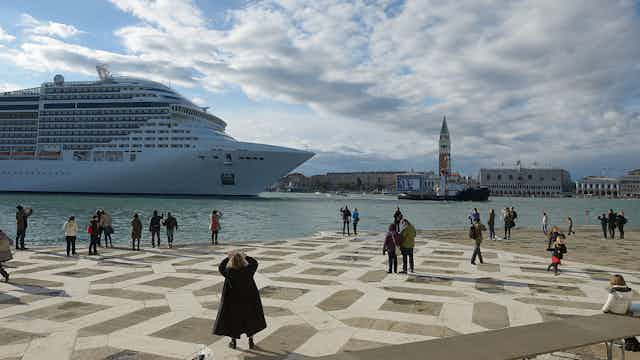The cruise industry tends to provoke strong responses, some for and – as seen by recent protests in Venice, Italy – some very much against.
On the one hand cruise devotees can describe the cruises they’ve taken, preferred destinations, cruise lines, ships – even their favourite captains. Nothing will dissuade these ardent fans from their annual trip, some of whom embark on 20 or more a year. In 2014, the Cruise Lines International Association reported two thirds of passengers were repeat guests. On the other hand, many people and organisations remain fiercely opposed to the industry, its employment policies, its record on environmental management, the opacity of its taxation arrangements, and the impact its super-sized ships have on destinations.
The recent protest in Venice saw residents take to the water to protest against huge cruise ships entering the city via the Grand Canal. This encapsulates many of the criticisms against the industry, especially those lines with ships capable of carrying 6,000 or more passengers and crew.
In a city such as Venice, which is slowly sinking beneath the waves, such huge vessels can cause further environmental damage, adding to the erosion of the canals and impact on the fragile ecosystem. These huge ships dwarf the city’s beautiful architecture, and disgorge thousands of passengers that choke the narrow canals and streets. Venice’s governing officials have consistently refused to acknowledge calls to limit the size and number of ships as they believe they bring greater number of tourists and economic benefits to the city.
A ship that undermines
Venice versus the cruise ships is just one example of growing unease about the scale of mass-market tourism. Cities and towns worldwide have started to protest this more vigorously, with Barcelona being another recent case. At the heart of these protests, especially with regards to cruise tourism, are concerns that it is economically, socially and environmentally unsustainable.
Tourists’ holiday expenditure in Europe is split roughly equally between accommodation, transport and other expenses. But for those on cruises their accommodation travels with them, removing a third of the destination’s potential income. Another third is affected because cruise passengers often return to the ship for lunch and dinner, included as part of their cruise package. In fact a significant number of passengers never get off the ship in port, preferring to make use the ships’ amenities, which are then at their least busy.

A ship that divides
The social impact of cruise tourism depends on the size of the destination, the extent to which the destination relies on cruise tourism for revenue, and the size of visiting cruise ships.
One feature of the cruise industry is their preference for offering “private islands” to their passengers. While some are indeed islands, mostly in the Caribbean, others are actually coastal peninsulas and so neither islands nor really private. They are leased by national governments to cruise lines who operate them as exclusive enclaves. This brings little economic benefit to local residents, as all food and refreshments are carried from the ship to the islands and beaches.
One such enclave, Labadee on the north-west coast of Haiti, permits a small number of local people to sell souvenirs twice a week during cruise season. Up to 50 more are employed as beach hands, tour guides, live exhibits, and toilet attendants. This type of “off the shelf” development appeals to governments looking for short term income, but while this approach offers cruise operators significant benefits, it has little to offer the local community.
A ship that pollutes
Criticism of cruise lines from an environmental perspective is growing around concerns about pollution and marine fuel’s role in climate change. While cruise ships account for only 8% of global shipping and recently-built mega-ships are able to fully process sewage and food waste on board, an increase in the fly-cruise market means that air miles should be included when calculating the true cost of cruise tourism pollution.
The cruise industry is reluctant to engage with any criticism. And while perhaps it’s unfair to suggest this is different to any other similarly-sized commercial entities, it is irrefutable that cruise lines are able to generate huge profits because they are incorporated in tax havens such as Bermuda, Liberia and Panama. These open shipping registries, commonly known as flags of convenience, means minimal regulation to comply with in terms of labour costs, environmental regulations and safety standards.
While legal and applicable to all shipping, cruise lines rely heavily on their workforce to satisfy their passengers’ high service expectations. That these same companies take any opportunity to avoid any legislation that would offer these workers wage protection and job security is just one of a long line of criticisms the industry is seemingly reluctant to acknowledge, let alone address. In a world that since the Panama Papers is increasingly aware of such issues, the industry cannot afford to ignore it much longer.

